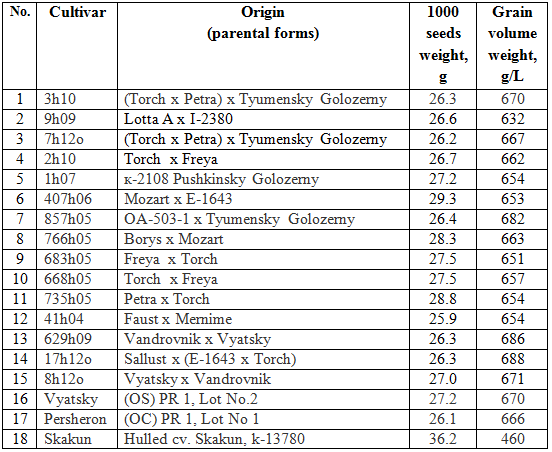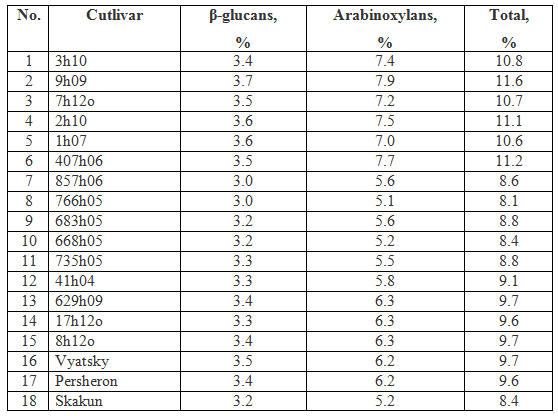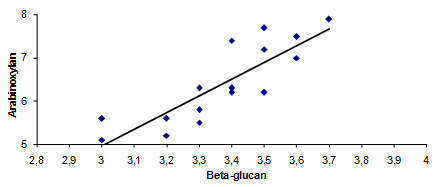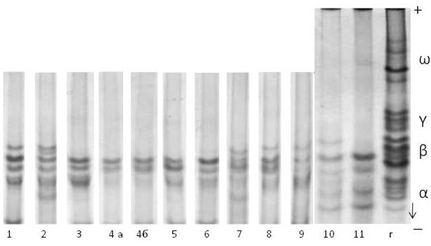DIETARY FIBERS AND AVENINS IN GRAIN OF THE NEWLY BRED NAKED OAT CULTIVARS
Красильников В.Н.1, Гаврилюк И.П.2, Баталова Г.А.3, Афонин Д.В.4, Попов В.С.5, Сергеева С.С.6, Лоскутов И.Г.7, Губарева Н.К.8
1Доктор технических наук, Профессор, Высшая школа биотехнологии и пищевых технологий, 2Доктор биологических наук, Профессор, Всероссийский институт растениеводства им. Н.И. Вавилова, 3ORCID: 0000-0002-3491-499X, Доктор с.-х. наук, Профессор, Вятская государственная сельскохозяйственная академия, 4Пивоваренная компания «Балтика», 5ORCID: 0000-0003-3274-7662, Кандидат технических наук, Высшая школа биотехнологии и пищевых технологий, 6Аспирант, Высшая школа биотехнологии и пищевых технологий, 7ORCID 0000-0002-9250-7225, Доктор биологических наук, Профессор, Всероссийский институт растениеводства им. Н.И. Вавилова, 8Всероссийский институт растениеводства им. Н.И. Вавилова
ПИЩЕВЫЕ ВОЛОКНА И АВЕНИНЫ ЗЕРНА ГОЛОЗЁРНЫХ СОРТОВ ОВСА НОВОЙ СЕЛЕКЦИИ
Аннотация
Исследованы некрахмальные полисахариды (β-глюканы и арабиноксиланы) зерна 15 перспективных и двух районированных сортов голозёрного овса, а также одного широко распространённого районированного плёнчатого сорта. Установлена положительная корреляция и соотношение между β-глюканами и арабиноксиланами овса, выделены сорта с высоким содержанием этих компонентов. В проламиновой фракции белков выявлено 11 типов спектров, различающихся по составу компонентов во фракциях α- и β-авенинов. А-авенины, наиболее токсичные при целиакии, у большинства голозерных сортов состоят из небольшого числа слабых компонентов, и представляется перспективным исследовать токсичность этих сортов в реакции с сыворотками больных целиакией. Выполненные исследования представляют непосредственный интерес с точки зрения пищевой инженерии продуктов функционального и специализированного назначения.
Ключевые слова: голозёрный овёс, авенин, функциональные продукты, некрахмальные полисахариды, β-глюканы, арабиноксиланы.
Krasilnikov V.N.1, Gavrilyuk I.P.2, Batalova G.A.3, Afonin D.V.4, Popov V.S.5, Sergeyeva S.S.6, Loskutov I.G.7, Gubareva N.K.8
1PhD in Engineering, Professor, Graduate School of Biotechnology and Food Science, 2PhD in Biology, Professor, Vavilov All-Russian Institute of Plant Genetic Resources, 3ORCID: 0000-0002-3491-499X, PhD in Agriculture, Professor, Vyatka State Agricultural Academy, 4Baltika Breweries, 5ORCID: 0000-0003-3274-7662, PhD in Engineering, Graduate School of Biotechnology and Food Science, 6Postgraduate student, Graduate School of Biotechnology and Food Science, 7ORCID: 0000-0002-9250-7225, PhD in Biology, Professor, Vavilov All-Russian Institute of Plant Genetic Resources, 8Vavilov All-Russian Institute of Plant Genetic Resources
DIETARY FIBERS AND AVENINS IN GRAIN OF THE NEWLY BRED NAKED OAT CULTIVARS
Abstract
Non-starch polysaccharides (β-glycans and arabinoxylans) of fifteen new and two commercially cultivated naked oat cultivars, as well as one hulled oat cultivar were studied.A strong correlation and ratio between the content of arabinoxylans and that of β-glucans have been determined. Cultivars with an increased content of these components have been selected. The studied cultivars demonstrated 11 electrophoretic banding patterns differing in α- and β-avenin fractions. In most naked oat cultivars were revealed several weak bands of α-avenin that are the most celiac-toxic peptides. It seems to be promising to assess toxicity of these cultivars from their reaction with celiac patients’ sera. The performed research is of immediate interest from the point of view of engineering functional and special purpose foods.
Keywords: naked oat, avenin, functional foods, non-starch polysaccharides, β-glucans, arabinoxylans.
Introduction
Popularity of the concept of functional foods has sharply increased in the last 10-15 years. The concept opens broad horizons for the food industry in terms of designing new added-value foods that may promote human health.
An important ingredient of such foods and diets are dietary fibers. They significantly influence various physiological processes and facilitate prevention and treatment of such diseases of our civilization as diabetes, obesity, osteoporosis, atherosclerosis and hypertension.
According to the European Food Safety Authority, the term “dietary fibers” refers to polysaccharides (carbohydrate polymers) consisting of three or more monomers (monoses) which are not digested or absorbed by small intestines and contain one or more
- polysaccharides occurring in natural foods;
- polysaccharides separated from the edible raw material by physical, enzymatic or chemical methods and proved by the accepted scientific methods to have positive physiological effects [1, 2].
The most common natural sources of dietary fiber are cereals that contain a unique combination of soluble and non-soluble dietary fibers, as well as polysaccharides combined with the low-molecular biologically active substances. Oat is an excellent source of dietary fiber [10, 7].
The non-starch polysaccharides of oat and other cereals consist of homopolysaccharides (hemicelluloses) and heteropolysaccharides (pentosanes). The most common representatives of the first group are β-glucans, while those of the second group are arabinoxylans.
B-glucans are composed mostly of the repeated cellotriosyl and cellotetraosyl units divided by simple β-(1,3)-linkages or by the consecutive β-(1,4)-linkages bound by glucose residues. Reviews of chemical and physiological properties of β-glucans are presented in [3, 13].
Cereal arabinoxylans have the main polymeric chain composed of the β-(1,3)-linked D-xylopyranosyl residues. The xylose links can be etherified with the α-L- arabinofuranose residues in the positions C(0)-3 and/or C(0)-2. An important structural parameter is the degree of arabinoxylan saturation which is characterized by the arabinose/xylose ratio [15]. The water-soluble and insoluble polysaccharides are distinguished.
Physiological and technological features of dietary fibers are determined by theirs colloid chemical properties, namely swelling and water-retaining capacity, solubility and interaction with other food system components. The majority of soluble fibers produce viscous and gel structures [16, 17]. The insoluble fibers are characterized by high water-retaining capacity. These parameters should be studied in order to design and engineer food products with a specified composition. The non-starch polysaccharides content and composition are defined by a cereal genotype and by phenotypic factors.
The aim of present research was studying chemical composition of the non-starch polysaccharides from grain of the national naked oat cultivars.
Material and methods
Fifteen new and two commercially cultivated (Vyatsky and Persheron) naked oat cultivars, as well as one hulled oat cultivar Skakun have been selected for the research. The 100 seeds weight and the grain volume weight were used as the morphological characters of grain (Table 1).
Table 1 – Naked oat cultivars from competitive tests at the Northeast Agricultural Research Institute, Kirov town, harvested in 2014

- The content of β-glucan in grain was determined using AACC 32-23. The crushed grain was suspended in the pH 6.5 buffer solution and incubated with the purified lichenase enzyme, and then the aliquot part of the filtrate was treated with β-glucosidase. Glucose was determined using the glucose oxidase/peroxydase reagent.
- The content of arabinoxylan and prolamin was determined by infrared reflectance spectra using OMNIC software (Sigma Biological Sample Library).
- The acid-polyacrylamide gel electrophoresis was used to determine the composition of prolamins.
Results
The data on the content of non-starch polysaccharides in grain of the newly bred oat cultivars are presented in Table 2.
Table 2 – Non-starch polysaccharides in oat cultivars and hybrids

It is obvious from the presented data that the average content of β-glucans in the studied cultivars was 3.4±0.2%, while that of arabinoxylan was 6.4±0.6%.
The range of β-glucan values variation is similar to those cited in literature sources for other oat types [8, 9, 14]. It should be noted that the average content of arabinoxylans in grain of the studied cultivars is approximately twice higher than that of β-glucans. It is also characteristic of other cereal crops (Table 3).
Table 3 – The content of β-glucans and arabinoxylans in different cereal crops (а)

The studied cultivars may be subdivided into three groups, that is, of cultivars with an increased content of arabinoxylans (7.0 – 7.7%, No.No. 1-6), of cultivars with a low content of arabinoxylans (5.1 – 5.8%, No.No. 7-12), and of those with a medium content of this polysaccharide (6.2 – 6.3%, No.No. 13-17).
All of the 17 studied naked oat cultivars have demonstrated a strong correlation between the content of arabinoxylans and that of β-glucans, R=0.85 (Fig. 1).
Such a correlation evidences, first, that the pentose phosphate and glycolytic cycles conjugate to some extent, and second, that the pentose phosphate cycle has a priority in the case with naked oats.
No stable correlation has been found to exist between such characters as the 1000 seeds weight, grain volume weight and the content of non-starch polysaccharids in grain. These findings are in agreement with the data from [11, 12].

Fig. 1 – The dependence of arabinoxylans content in grain of naked oat cultivars on that of β-glucans
The performed research is of immediate interest from the point of view of engineering functional and special purpose foods. It may be interesting to investigate possibilities of using the benefits of arabinoxylans in producing grain ingredients with a new health improving potential.
Such ingredients may be represented by the modified soluble dietary fibers and the prebiotic oligosaccharides.
Another direction of research is the study of rheological properties of arabinoxylans that is directly related to the oat processing technology, in particular, to the technology of flour products manufacturing on the basis of these properties, to the regulation of viscous and elastic properties of dough and textural characteristics of the end products. It has been mentioned above that aqueous dispersions of arabinoxylans have a high potential for producing viscous dispersions and gel-forming structures, while the insoluble arabinoxylans are characterized by a high water-retaining capacity [5, 6].
Characterization of the prolamin fraction is of special importance for the use of oat in the production of functional and special purpose foods because the antigenic components of prolamins (epitopes) provoke disruption of the functional activity of the human immunity system. The present research was confined to determining the total avenins (oat prolamins) in grain of the studied cultivars (Table 4) and to determining composistion the avenin fraction by electrophoresis (Fig. 2). The average content of this protein fraction was found to equal 1.6±0.2%, it being quite similar in the studied cultivars.
Table 4 – Prolamins and types of prolamin banding patterns in oat cultivars and hybrids

Like in wheat, prolamins are represented in most cereals by four fractions, i.e., - α, β, γ, and ω. Oat grain contains only α and β-avenins. The studied cultivars demonstrated 11 electrophoretic banding patterns differing in α and β-avenin fractions.

Fig. 2 – Types of avenin electrophoretic banding patterns in the studied oat cultivars (1-11), wheat gliadin (г), α, β, γ, and ω – prolamin fractions
The frequencies of occurrence of banding pattern types are given in Table 4. Nine cultivars have demonstrated similarity in this respect, while the others had kernels with two or three different types of banding patterns. In functional and technological terms, as well as in relation to the production of gluten-free products, the composition of α-avenin is of special interest. Its molecules have disulfide bonds and are proteolysis-resistant. It is in this prolamin fraction that the largest number of the celiac-toxic peptides has been found. Therefore, the number and intensity of this fraction’s bands may be used for the preliminary screening of cultivars that may be promising for the gluten-free diets. It has been demonstrated to be true for the hulled cultivars [18, 19]. It is obvious from Fig. 2 that in most naked oat cultivars α-avenin electrophoretic patterns include several weak bands. It seems to be promising to assess toxicity of these cultivars from their reaction with celiac patients’ sera.
The screening of grain of the new naked oat cultivars for the content of non-starch polysaccharids and avenin composition is definitely important for the assessment of their use in food industry for producing functional and special purpose foods.
Список литературы / References
- EFSA (European Food Safety Authority) ”Statement of the Scientific Panel on Dietetic Products, Nutrition and Allergies on a request from the Commission related to dietary fibre”. – 2007. – URL: http://www.icc.or.at/news/EFSA.Panel.Statement.on.Dietary.Fibre.pdf (accessed 20.05.2008);
- Buttriss J. Fibre and health / J. Buttriss // Supplement to AgroFood Industry hi-tech. – 2009. – 20(3). – P. 4-8;
- Miller Jones. J. Dietary fibre intake, disease prevention, and health promotion: An overview with emphasis on evidence from epidemiology / J. Miller Jones // Book “Dietary Fibre, bioactive carbohydrates for food and feed”, editors: W. van der Kamp, N.-G. Asp, J. Miller Jones, G. Schaafsma, Wageningen Academic Publishers. – the Netherlands, 2004. – P.143-165;
- Aman P. Analysis of starch and other main constituents of cereal grains / P. Aman, K. Hesselman // Swedish J. Agr. Res. – 1984. – 14. – P.135-139;
- Courtin C. M. Arabinoxylans and endoxylanases in wheat flour bread-making / C. M. Courtin, F. A. Delcour // J. Cereal Sci. – 2002. – 35, P.225-243;
- Goesaert H. Wheat flour constituents: how they impact bread quality, and how to impact their functionality / H. Goesaert, K. Brijs, K. Varaverbeke and others // Trends Food Sci. Technol. – 2005. – 16 – P.12-30;
- Poutanen K. Dietary fibre in a gluten-free diet / K. Poutanen // The Science of gluten-free foods and beverages, edited by E. K. Arendt and F. Dal Bello, AACC International Inc. – 2009. – P.125-129;
- Holthaus J. F. Inheritance of beta-Glucan content of oat grain / J. F. Holthaus, J. B. Holland, P. J. White and others // Crop Science. – 1996. – 36. – P. 567-572;
- Koom Ch. C. Enzymatic Analysis of beta-Glucan content in different oat genotype / Ch. C. Koom, P.F. White // Cereal chemistry. – 1993. – 70(5). – P.539-542;
- Salovaara H. Oats – an overview from a celiac disease point of view / H. Salovaara, P. Kanerva, K. Kaukinen // The Science of Gluten-free Foods and Beverages, edited by E. K. Arendt and F. Dal Bello, AACC International Inc., St. Paul, USA. – 2009. – P.69-81;
- Peterson D. M. Genotype and environment effects on oat beta-glucan concentration / D. M. Peterson // Crop Sci. – 1991. – 31. – P. 1517-1520;
- Miller S. S. Oat beta-glucans: an evaluation of eastern Canadian cultivars and unregistered lines / S. S. Miller, D. J. Vincent, F. Weisz // Can. J. Plant Sci. – 1993. – 73. P.429-436;
- Wood P. J. Functional oat products / P. J. Wood, M. U. Beer // Book “Functional Foods”, biochemical and processing aspects, edited by G. Mazza, Technomic Publishing co. Inc., Lancaster, Basel. – 1998. – P.1-39;
- Brunner B. R. Oat grain beta-glucan content as affected by nitrogen level, location, and year / B. R. Brunner, R. D. Freed // Crop Sci. – 1994. – 34. – P.473-476;
- Delcour J. A. Enzymes in the production of functional food ingredients – the arabinoxylan case / J. A. Delcour, W. F. Broekaert, C. M. Coutin and others // The Science of Gluten-free Food and Beverages, edited by E. K. Arendt and F. Dal Bello, AACC International Inc., St. Paul, USA. – 2009. – P.129-140;
- Anttila H. Viscosity of beta-glucan in oat products / H. Anttila, T. Sontag-Strohm, H. Salovaara // Agricul. and Food Science. – 2004 – 13(1-2). – P.80-87;
- Wood P. J. Physiological effects of β-D-glucan rich fractions from oats / P. J. Wood, F. W. Anderson, F. T. Braaten and others // Cereal Food World. – 1989. – 34(10). – P.879-881;
- Гаврилюк И. П. Проламины и целиакия / И. П. Гаврилюк, Н. В. Алпатьева, Н. А. Леонтьева и др. // Аграрная Россия. – 2004. – №6. – С. 41-49.
- Gavrilyuk I. P. The avenins and celiac disease / I. P. Gavrilyuk, N. K. Gubareva, I. N. Perchuk and others // 3rd Symposium on Gluten-Free Cereal Products and Beverages. – Vienna, Austria, 2013.
Список литературы на английском языке / References in English
- EFSA (European Food Safety Authority) ”Statement of the Scientific Panel on Dietetic Products, Nutrition and Allergies on a request from the Commission related to dietary fibre”. – 2007. – URL: http://www.icc.or.at/news/EFSA.Panel.Statement.on.Dietary.Fibre.pdf (accessed 20.05.2008);
- Buttriss J. Fibre and health / J. Buttriss // Supplement to AgroFood Industry hi-tech. – 2009. – 20(3). – P. 4-8;
- Miller Jones. J. Dietary fibre intake, disease prevention, and health promotion: An overview with emphasis on evidence from epidemiology / J. Miller Jones // Book “Dietary Fibre, bioactive carbohydrates for food and feed”, editors: W. van der Kamp, N.-G. Asp, J. Miller Jones, G. Schaafsma, Wageningen Academic Publishers. – The Netherlands, 2004. – P.143-165;
- Aman P. Analysis of starch and other main constituents of cereal grains / P. Aman, K. Hesselman // Swedish J. Agr. Res. – 1984. – 14. – P.135-139;
- Courtin C. M. Arabinoxylans and endoxylanases in wheat flour bread-making / C. M. Courtin, F. A. Delcour // J. Cereal Sci. – 2002. – 35, P.225-243;
- Goesaert H. Wheat flour constituents: how they impact bread quality, and how to impact their functionality / H. Goesaert, K. Brijs, K. Varaverbeke and others // Trends Food Sci. Technol. – 2005. – 16 – P.12-30;
- Poutanen K. Dietary fibre in a gluten-free diet / K. Poutanen // The Science of gluten-free foods and beverages, edited by E. K. Arendt and F. Dal Bello, AACC International Inc. – 2009. – P.125-129;
- Holthaus J. F. Inheritance of beta-Glucan content of oat grain / J. F. Holthaus, J. B. Holland, P. J. White and others // Crop Science. – 1996. – 36. – P. 567-572;
- Koom Ch. C. Enzymatic Analysis of beta-Glucan content in different oat genotype / Ch. C. Koom, P.F. White // Cereal chemistry. – 1993. – 70(5). – P.539-542;
- Salovaara H. Oats – an overview from a celiac disease point of view / H. Salovaara, P. Kanerva, K. Kaukinen // The Science of Gluten-free Foods and Beverages, edited by E. K. Arendt and F. Dal Bello, AACC International Inc., St. Paul, USA. – 2009. – P.69-81;
- Peterson D. M. Genotype and environment effects on oat beta-glucan concentration / D. M. Peterson // Crop Sci. – 1991. – 31. – P. 1517-1520;
- Miller S. S. Oat beta-glucans: an evaluation of eastern Canadian cultivars and unregistered lines / S. S. Miller, D. J. Vincent, F. Weisz // Can. J. Plant Sci. – 1993. – 73. P.429-436;
- Wood P. J. Functional oat products / P. J. Wood, M. U. Beer // Book “Functional Foods”, biochemical and processing aspects, edited by G. Mazza, Technomic Publishing co. Inc., Lancaster, Basel. – 1998. – P.1-39;
- Brunner B. R. Oat grain beta-glucan content as affected by nitrogen level, location, and year / B. R. Brunner, R. D. Freed // Crop Sci. – 1994. – 34. – P.473-476;
- Delcour J. A. Enzymes in the production of functional food ingredients – the arabinoxylan case / J. A. Delcour, W. F. Broekaert, C. M. Coutin and others // The Science of Gluten-free Food and Beverages, edited by E. K. Arendt and F. Dal Bello, AACC International Inc., St. Paul, USA. – 2009. – P.129-140;
- Anttila H. Viscosity of beta-glucan in oat products / H. Anttila, T. Sontag-Strohm, H. Salovaara // Agricul. and Food Science. – 2004 – 13(1-2). – P.80-87;
- Wood P. J. Physiological effects of β-D-glucan rich fractions from oats / P. J. Wood, F. W. Anderson, F. T. Braaten and others // Cereal Food World. – 1989. – 34(10). – P.879-881;
- Gavrilyuk I. P. Prolamini i celiakija [The prolamins and celiac disease] / I. P. Gavrilyuk, N. V. Alpatyeva, N. A. Leontyeva and others // Agrarnaja Rossija [Agrarian Russia]. – 2004. – N.6. – P.41-49. [in Russian];
- Gavrilyuk I. P. The avenins and celiac disease / I. P. Gavrilyuk, N. K. Gubareva, I. N. Perchuk and others // 3rd Symposium on Gluten-Free Cereal Products and Beverages. – Vienna, Austria, 2013.
